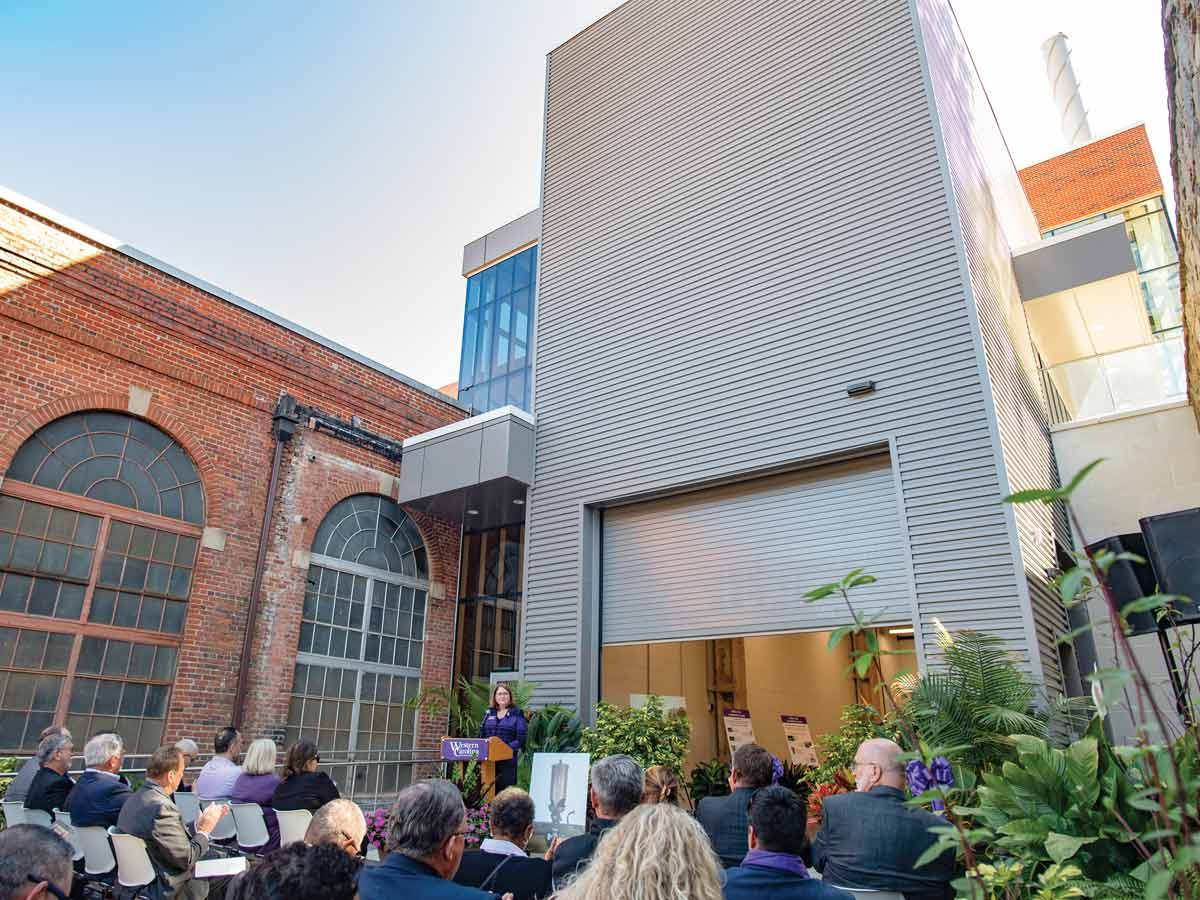With replacement complete, century-old WCU steam plant to retire
 Chancellor Kelli R. Brown speaks to the crowd gathered Oct. 21 to cut the ribbon on the new steam plant. WCU photo
Chancellor Kelli R. Brown speaks to the crowd gathered Oct. 21 to cut the ribbon on the new steam plant. WCU photo
After nearly a century in operation, years of inspiring trepidation at winter’s approach and $33 million from the state legislature, Western Carolina University’s antique steam plant is approaching its final retirement. In a ribbon-cutting ceremony Friday, Oct. 21, about 100 people gathered to celebrate completion of the new facility, which is expected to come online in the next month or so.
“For decades (our facilities and maintenance staff), professional technicians led most recently by Mr. Terry Riouff, babied, cajoled, coaxed and even applied percussive therapy when needed to a nearly 100-year-old steam plant functioning well past is intended lifespan,” Provost Richard Starnes told the crowd. “They did this day in and day out, 24/7, 365 days a year. Then they turned their attention to ensuring that this new steam plant would meet the needs of the campus for another century. What a legacy they leave.”
Road to replacement
The original steam plant was completed in 1924, its boiler hauled to campus using a large team of oxen. The oldest boiler still in use today was installed in 1966, when Lyndon B. Johnson was president and Dr. Seuss’s “How the Grinch Stole Christmas” aired for the first time. The other two were installed in 1969 and 1973.
Replacing the aged steam plant was a priority for the late Chancellor David O. Belcher throughout his time at WCU, as he and his team pushed for legislators from jurisdictions across the state to put their weight behind this non-glamorous but much-needed funding request. When state leaders came to visit, Belcher would have signs displayed on the boilers, saying things like, “This boiler was installed when Harry Truman was president.” That statement was true of a boiler that remained in use until 2016, when three temporary emergency boilers were installed to replace the 65-year-old machine that was no longer capable of reliably producing steam.
“No longer will we have to be thinking about, ‘Oh, we can’t have a cold winter. If the winter’s really cold, what might happen?’” said Chancellor Kelli R. Brown.
Several times over the years, administrators would look at the weather forecast and worry about the old plant’s ability to keep up. If it failed, they’d have to close the dorms and send the university’s 4,000 campus residents home.
Related Items
“Like most infrastructure, nobody cares about it until it fails,” said Riouff, the steam plant supervisor. “The new steam plant gives us redundancy. We didn’t have that with the old steam plant.”

- A team of oxen haul the boiler to campus in 1924. WCU photo
‘Beyond thrilled’
N.C. Labor Commissioner Josh Dobson was a state representative from the 85th district in Avery, McDowell and Mitchell counties when Belcher’s administration began its hard press to replace the steam plant. During the ribbon-cutting ceremony, Dobson recalled the surprise expressed by Nelson Dollar, the senior chairman of the Appropriations Committee at the time, when Dobson entered Dollar’s office after taking a tour of the steam plant, asking to make the project a funding priority. It was an unusual request because WCU wasn’t in Dobson’s district — nobody in that community could vote for him when election time came around.
But Dobson, whose wife is a WCU alumna, said that being part of a “big consequential thing” like the steam plant replacement was what he loved most about being a legislator.
“Those of us who have been doing this for a while understand the fleeting nature of politics and perhaps know that our time in the arena is limited,” he said. “We understand that most of the votes we cast will be forgotten. We understand that most of the speeches we give in time will not be remembered. But being able to be part of something like this won’t be forgotten anytime soon.”
The steam plant saga began its approach toward a conclusion in 2017, when the legislature appropriated $750,000 for the design of a steam plant replacement. Initial funding for construction came the next year, when the state budget included $16.5 million to fund the first half of the project. The second $16.5 million installment was included in the 2020 budget.
Belcher was no longer acting as chancellor when the legislature approved a budget bill with that initial funding on June 1, 2018. He was home, battling the brain cancer that would claim his life on June 17 — less than a week after the budget was codified through a veto override June 12. But he released a statement expressing his joy at seeing the project pull through.
“I am beyond thrilled that our state legislators have included significant funding to address one of the most acute and critical infrastructure needs facing our campus — our antiquated steam plant, or, as I like to call it, ‘steam museum,’” Belcher said at the time. “Obtaining the funding necessary to upgrade the steam plant was the top priority left unaccomplished when I began medical leave at the beginning of this year, and I am heartened to learn of its inclusion in the budget plan.”
Belcher’s widow, Susan Belcher, attended the Oct. 21 ribbon-cutting, all smiles at seeing her late husband’s vision come to pass.
Many other current and former elected officials were there as well, including Sen. Kevin Corbin, former Sen. Jim Davis, Rep. Mike Clampitt, Sen. Ralph Hise, Sen. Deanna Ballard and Rep. Brian Turner. Representatives from the offices of Sens. Richard Burr and Thom Tillis were in attendance, as well as Eastern Band of Cherokee Indians Tribal Council Chairman Richard French and Yellowhill Rep. T.W. Saunooke.

- Don Hair, manager of the steam plant construction project, gives a tour of the boiler room Oct. 21. WCU photo
The new plant
The new steam plant is a modern, two-story structure that stands adjacent to the original plant. Boilers, piping and the control room are located on the main floor above, with water pumps, water treatment equipment and compressors housed on the lower floor.
While the new facility also has its own smokestack, the original smokestack remains as a nod to university history, as does a portion of the original building. Its brick façade faces Central Drive and its large, arcing windows add a visually appealing architectural element. The building will house a lobby, administrative offices and display space for old plant equipment. The plant’s original steam whistle, used to signal the start and end of the workday, lunch break, and special events or warnings, will be installed at the new plant.
While the steam plant originally ran on coal, it’s been using natural gas since 2006. The new plant will also rely on natural gas, with No. 2 fuel oil as a backup source.
Though the new plant’s capacity of 110,000 pounds per hour is similar to the current output of 107,000 pounds per hour, the new facility will be much more efficient and reliable. The current facility is only 50% efficient at full capacity, while the new plant is expected to be 90% efficient. Original plans had called for a new steam plant capable of producing 150,000 to 170,000 pounds per hour, but university leaders ultimately decided that wasn’t necessary, construction project manager Don Hair said during a tour of the building. The university is growing, but the newer buildings are more fuel-efficient than the older ones — replacing the Scott and Walker residence halls with new construction significantly reduced fuel demands, Hair said.
“This was my top capital priority when I started working here more than 20 years ago,” said Joe Walker, associate vice chancellor for facilities management. “I knew the old plant would not last forever. Now, I can sleep better at night knowing that we have a new facility.”










